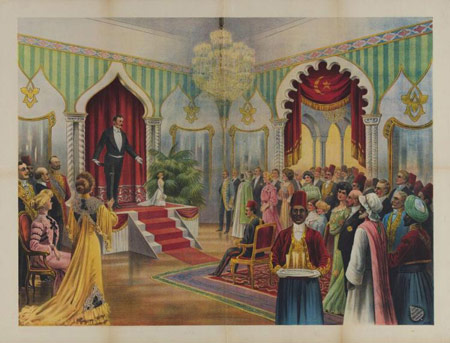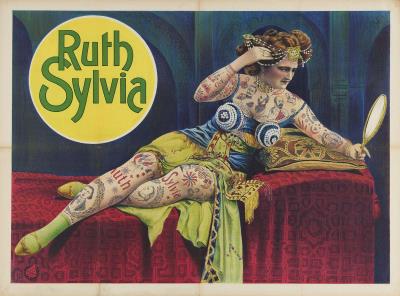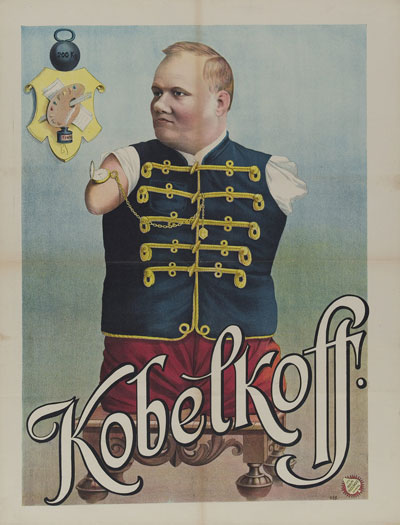The purpose of the Circus Museum site is to make circus-related cultural heritage available to the public. The historical images featured below contain outdated and derogatory language, and the way people are depicted may be regarded as offensive. Their online availability is, however, in no way intended to offend anyone.
The History of ‘Freak Shows’
Gaping at others for entertainment is a centuries-old pastime. Already in sixteenth-century Europe, ‘wonders of nature’ or ‘freaks of nature’, a term used for humans as well as animals, were put on display at royal courts. Spectators saw a parade of people with physical deformities, exotic animals and people from the lands that were being discovered and conquered by European explorers. The shows in Europe were often small-scale, with the audience paying a small fee to be allowed a peek behind the curtain at the ‘freak’ hiding there. In spring and summer, such shows travelled to the numerous fairs and annual markets held in larger and smaller cities. In winter, performances were held in beer houses, theatres, museums and shops. Sometimes freak shows were part of larger entertainment shows, especially in North America, where large circuses toured the country to pitch their tents. From 1840 to 1914, the sideshow was a constant feature of the entertainment on offer in Europe and in America.

What is a ‘Freak’?
Show people often differentiated between various types of ‘freaks’. A first category was that of the ‘born freaks’, people with congenital deformities such as restricted growth. Another one was that of the ‘self-made freaks’, who had turned their bodies into a spectacle, for instance by covering themselves in tattoos from top to toe (TEY0010000670). This distinction suggests that people can be born as ‘freaks’. The term ‘freak’, however, is a label we give to people, it is not something people are born with. It results from the cultural gaze with which we view other people’s bodies, and it is something that changes through time and circumstance. In medieval Europe, for instance, a physical deformity might be seen as a punishment inflicted by God. Today, we use terms like disability or impairment when we speak of a physical limitation.
In the nineteenth century and the early twentieth century, ‘freaks’ were people who physically deviated from the norm, but who also often disrupted social boundaries. The bearded woman, for instance, was a ‘freak’, not just because of her exceptional hair growth, but also because she challenged gender stereotyping (TEY001014506).
This is also how people of colour ended up in freak shows, in some cases even when there wasn’t actually anything physically ‘wrong’ with them. In such cases, their ‘exotic’ appearance was sufficient reason for a white audience to regard them as ‘freaks’. Exhibiting people who were different served to define the norm and differentiate between those who satisfied it and those who did not. In this way, the freak show was an important instrument to disseminate and confirm certain social ideas.

The Public Fascination with Extraordinary Bodies
This kind of spectacle was very popular with the public. Viewers were attracted by the aura of mystery surrounding these so-called ‘human wonders’. Their extraordinary bodies challenged the boundaries of the known and the imaginable. Showpeople and impresarios, like the famous American showman P.T. Barnum, used every trick in the book to lure the crowds. Extremely small people were juxtaposed to exceptionally tall people to accentuate their size (TEY001008926). Excessive stories were made up about the ‘primitive’ nature of people of colour to stress their ‘descent’ (TEY0010002785). Publicity material abounded in superlatives and nicknames. Slogans like ‘What is it?’ catered to the public’s curiosity and invited viewers to see and judge with their own eyes what the spectacle was all about.

Behind the Scenes
The working conditions of the performers taking part in these shows were very diverse. Being labelled as a ‘freak’ could be extremely humiliating and hurtful. In some cases, they were clearly exploited by relatives or impresarios, though this was not always so. People ended up in public entertainment through a variety of circumstances. Performers who had been exhibited from a young age or were mentally challenged, were often unable to stand up for themselves. Others, who had a serious physical impairment, found it difficult to find ordinary employment. Some of them considered it more honourable to perform in a show and earn their own living rather than having to rely on charity. Nikolai Kobelkoff, who was born without limbs, first toured as a ‘freak’. He was so successful that he later ran his own cinema at the fair and was able to live comfortably (TEY0010002447). A small group deliberately opted for a career as a ‘freak’. To them, their singular appearance was not a source of shame, but of pride, and they actively controlled their image and performance. Like Kobelkoff, some of them achieved true star status.
A Thing of the Past?
In the twentieth century, this type of public spectacle increasingly came under attack, with the shows being seen as disrespectful and exploitative. People with physical impairments, it was felt, should not be exhibited as entertainment. They suffered from medical conditions that should be addressed by doctors. The term ‘freak’ was no longer appropriate to refer to deviant bodies. Instead, terms like disability and disablement came to be used. These once so popular shows, therefore, seem to be a thing of the past. Still, gazing at someone who is different, or in other words, who seems to deviate from the norm, remains a popular source of entertainment and unholy glee to this day.


